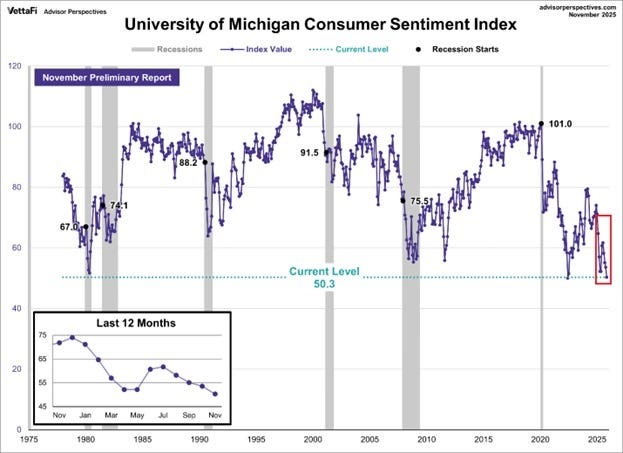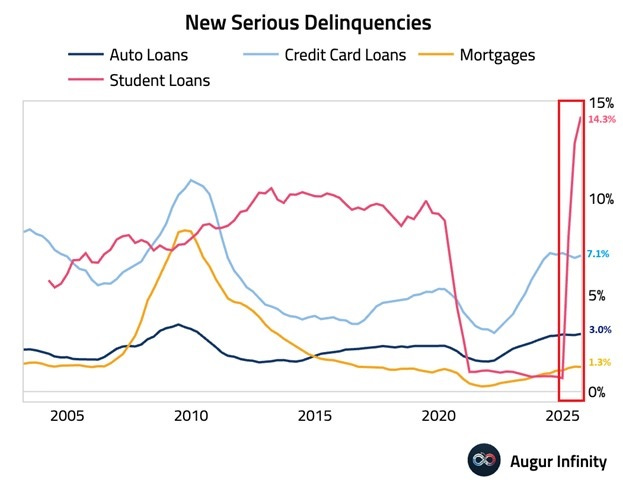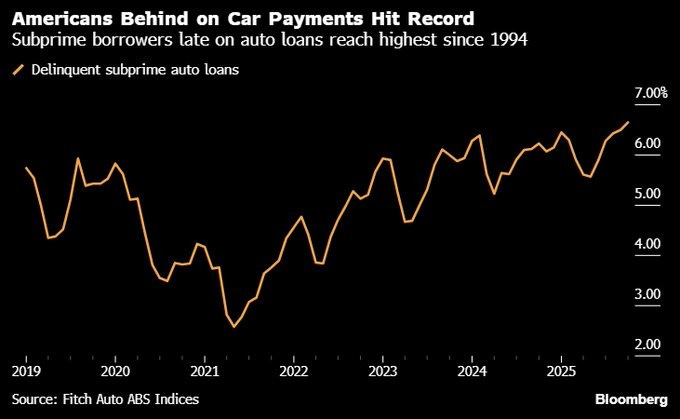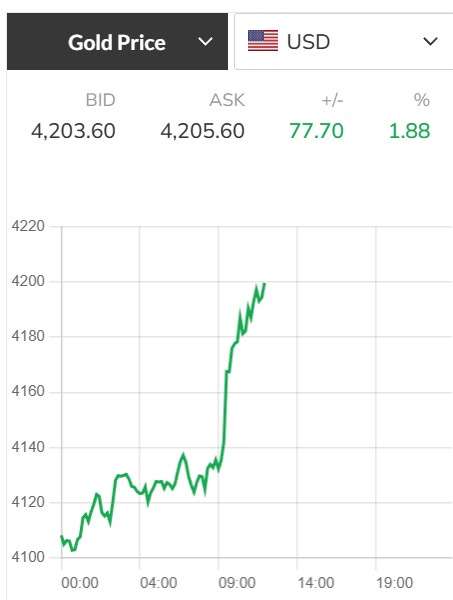by tim » Wed Nov 12, 2025 10:26 pm
https://rubino.substack.com/p/recession ... d-for-good
Recession Watch: Spooked For Good Reasons
A widely-followed consumer sentiment index just hit its second-worst level on record:

Why are Americans so spooked? Perhaps it’s the prospect of being replaced by AI. So far in 2025, major layoff announcements include:
Amazon: 14,000 job cuts
UPS: 48,000
Intel: 20,000
Microsoft: 6,000
Target: 1,800
Meta: 600 (from its AI division!)
Salesforce: 4,000
Or maybe it’s that student loan payments have resumed, and for some, it’s one bill too many. See the red line on the following chart:

Or maybe it’s those “car mortgages” that were so popular for a while:

Here Come The Stimmy Checks
With busts looming on multiple fronts, how far off can some form of bailout be? Not far at all, apparently:
Trump floats $2,000 tariff rebate checks: Here’s what you need to know
(CNBC) - Over the weekend, President Donald Trump suggested paying Americans directly for their health-care costs and sending tariff rebate checks to families, not unlike the stimulus payments issued during the Covid-19 pandemic.
In a Truth Social post on Saturday, Trump wrote, “Republicans should give money DIRECTLY to your personal HEALTH SAVINGS ACCOUNTS.”
The president also floated the idea that a tariff “dividend” was possible. “A dividend of at least $2000 a person (not including high income people!) will be paid to everyone,” he wrote in another post Sunday on Truth Social.
Panic Time
Stimmy checks are the most blatant and least effective tool for managing an overindebted economy. They are, however, a good way to telegraph panic in a way that smart investors can understand. Keep stacking:

[url]https://rubino.substack.com/p/recession-watch-spooked-for-good[/url]
[quote]Recession Watch: Spooked For Good Reasons
A widely-followed consumer sentiment index just hit its second-worst level on record:
[img]https://substackcdn.com/image/fetch/$s_!5Fk8!,f_auto,q_auto:good,fl_progressive:steep/https%3A%2F%2Fsubstack-post-media.s3.amazonaws.com%2Fpublic%2Fimages%2Fc4e40da1-be13-4482-8c32-75a612d86c78_623x453.jpeg[/img]
Why are Americans so spooked? Perhaps it’s the prospect of being replaced by AI. So far in 2025, major layoff announcements include:
Amazon: 14,000 job cuts
UPS: 48,000
Intel: 20,000
Microsoft: 6,000
Target: 1,800
Meta: 600 (from its AI division!)
Salesforce: 4,000
Or maybe it’s that student loan payments have resumed, and for some, it’s one bill too many. See the red line on the following chart:
[img]https://substackcdn.com/image/fetch/$s_!llwe!,f_auto,q_auto:good,fl_progressive:steep/https%3A%2F%2Fsubstack-post-media.s3.amazonaws.com%2Fpublic%2Fimages%2Fd8ddd21c-c8c8-4c17-b034-8df4d6f75940_623x486.jpeg[/img]
Or maybe it’s those “car mortgages” that were so popular for a while:
[img]https://substackcdn.com/image/fetch/$s_!ssDZ!,f_auto,q_auto:good,fl_progressive:steep/https%3A%2F%2Fsubstack-post-media.s3.amazonaws.com%2Fpublic%2Fimages%2F2cfd97cb-809c-452e-ba8d-9e017074acd6_680x419.jpeg[/img]
Here Come The Stimmy Checks
With busts looming on multiple fronts, how far off can some form of bailout be? Not far at all, apparently:
Trump floats $2,000 tariff rebate checks: Here’s what you need to know
(CNBC) - Over the weekend, President Donald Trump suggested paying Americans directly for their health-care costs and sending tariff rebate checks to families, not unlike the stimulus payments issued during the Covid-19 pandemic.
In a Truth Social post on Saturday, Trump wrote, “Republicans should give money DIRECTLY to your personal HEALTH SAVINGS ACCOUNTS.”
The president also floated the idea that a tariff “dividend” was possible. “A dividend of at least $2000 a person (not including high income people!) will be paid to everyone,” he wrote in another post Sunday on Truth Social.
Panic Time
Stimmy checks are the most blatant and least effective tool for managing an overindebted economy. They are, however, a good way to telegraph panic in a way that smart investors can understand. Keep stacking:
[img]https://substackcdn.com/image/fetch/$s_!Cmcy!,f_auto,q_auto:good,fl_progressive:steep/https%3A%2F%2Fsubstack-post-media.s3.amazonaws.com%2Fpublic%2Fimages%2F3e94fa6e-e018-486a-ba92-0bc27cdd085f_453x600.jpeg[/img]
[/quote]